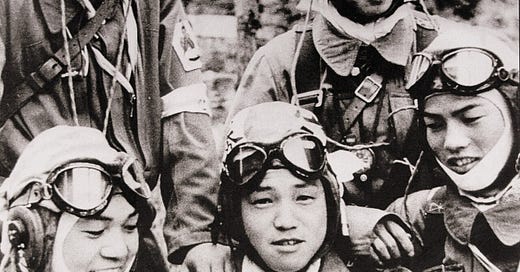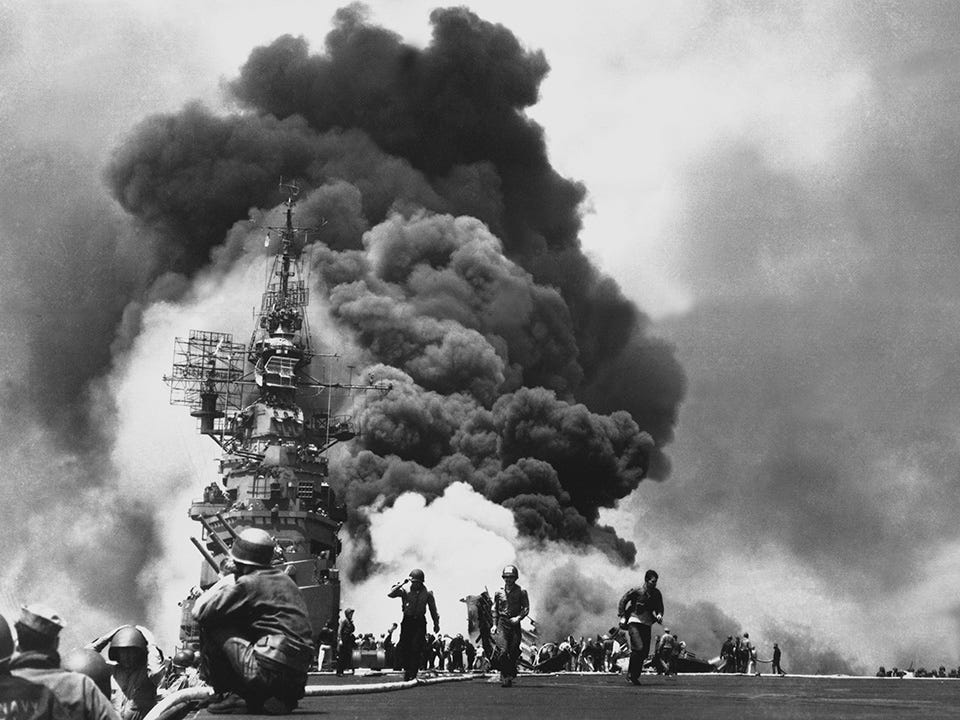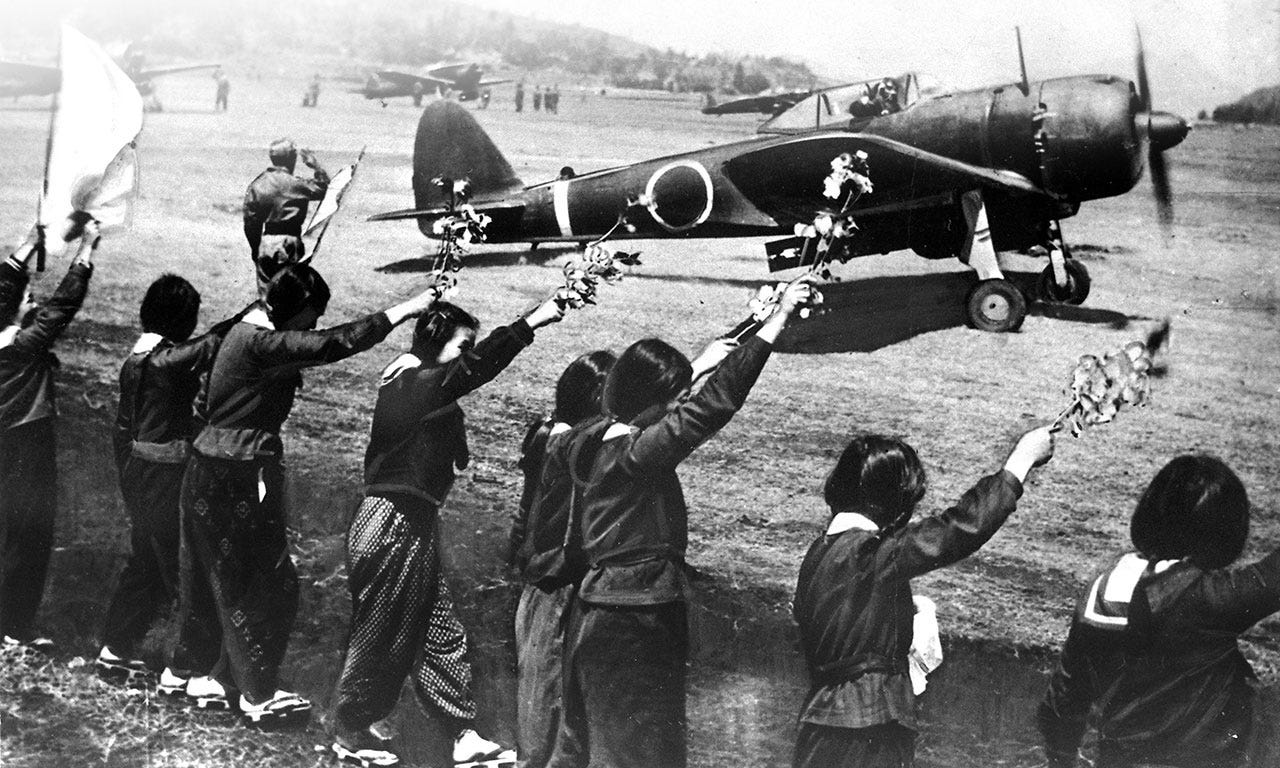Last week, I explored the rise of an ideal of sacrifice in Japan - from the opening of the samurai era in the late 1100s to the surprise Christian conversions of large numbers of ex-samurai shortly after that era closed in the late 19th century. This week, I want to look at what happened when a generation of war-leaders in Japan tried to give the sacrificial ideal a zombie-like final act.
For many, the signature sound of the kamikaze will always be the drone of an aeroplane engine followed by a catastrophic explosion. For me, it’s the rustle of fabric.
The kamikaze corps, or Special Attack Force, was launched in the autumn of 1944 on a voluntary basis. Sometimes recruitment was a matter of marching young conscripts into a hall, handing them blindfolds to put on, and then giving them a lecture about Japan’s hour of need and the importance of sacrifice. Those who wished to volunteer were asked to raise their hands.
The blindfolds were intended to eliminate peer pressure. In reality, the sound made by people’s uniforms when they thrust their hands into the air served to create pressures of its own.
What if everyone but you was putting up their hands? Where would that leave you - and by extension your family, whose fortunes amongst nosy and hard-pressed neighbours rested in part on your military reputation?
Sometimes, even those who didn’t volunteer found that their names had been added to the sign-up list anyway.
Five kamikaze pilots, pictured in May 1945. The boy holding the puppy was 17. He died the next day in a kamikaze attack.
By this point in the war, Japan had been on the retreat for well over a year. Japanese strategists were focused on making the cost to the Allies of taking each new piece of territory so prohibitively high that the Americans in particular might be persuaded to come to the negotiating table. There persisted in Japan a view that whereas the Japanese were willing to fight to the end, soft and decadent Americans would eventually tire of seeing young men returning home injured or in bodybags.
Eighty years ago this month and next, that theory was tested to destruction on the island of Okinawa and on the seas around it. Could kamikaze attacks weaken American naval strength and water down their resolve?
These were not regarded in Japan as suicide missions. They were combat deaths. Planes were emptied of everything inessential so that explosives could be packed inside, and especially into the nose. Pilots would then fly low in hopes of evading American radar, weaving this way and that on their approach so that gunners would have trouble targeting them. If a pilot managed to strike a ship and start a fire, the physical and psychological damage inflicted on the enemy could be immense.
The pilots were assured by their superiors that a successful mission would make gods of them. ‘Aim for the smokestack,’ one kamikaze manual advised. ‘Crash with your eyes wide open. Many have done so before you – they will tell you what fun they had . . .’
Above: a kamikaze attack off Okinawa, 1945.
Below: the USS Bunker Hill is hit by a double kamikaze strike, also off Okinawa (May 1945).
Research by Emiko Ohnuki-Tierney and others on kamikaze pilot diaries reveals the ways in which a very old ideal of sacrifice in Japan was repurposed by the country’s wartime leaders.
Where Germany and Italy went through social and political convulsions in the early 20th century, resulting in Hitler and Mussolini, Japan’s drift into authoritarianism was more a matter of steadily turning up the dial on existing values and preoccupations.
The roots of this gradual repurposing went back to the 1920s, when young military officers began to make the claim that contemporary Japanese society had lost its bearings. Western music, literature and film, they argued, was contributing to dangerous levels of self-absorption amongst urban Japanese in particular. They had forgotten their roots in a co-operative way of life, where the fortunes of the group mattered more than those of the individual.
A model for that co-operative, self-sacrificial way of life, suggested some military ideologues, still existed - in the armed forces. They hoped to see Japanese society reformed in line with this ideal, and were determined to defend it aggressively in the Asia-Pacific region, where they believed it to be threatened by the encirclement of the ‘ABCD’ powers - America, Britain, China and the Dutch (in the Dutch East Indies).
By the spring of 1945, those ideologues had achieved a perverse form of their goal: forced sacrifice, at home and abroad. Urban Japanese saw their lights turned off, their cities dismantled for scrap-iron, husbands and sons conscripted and other family members half-starved through rationing. Added to all this sacrifice was the sight of what remained of their cities being set alight by Allied air-raids, with napalm used to destroy large swathes of Japan’s wood-and-paper infrastructure. Abroad, the Imperial Japanese Army brutally sacrificed large numbers of innocents, from Nanking to Manila. No surprise that few in the US, once made aware of these atrocities, felt inclined to mourn the suffering of Japanese civilians.
From the beginning, the kamikaze pilots were portrayed as the ultimate, deeply poignant expression of the sacrifice required of the Japanese people as a whole. Heavy use was made of cherry blossom symbolism and its connections with fleeting youth and beauty: just as cherry trees bloom briefly and brilliantly, so these young pilots would shine brightly before their lives were extinguished. Cherry blossom motifs were sometimes painted onto planes. Pilots were waved off by young girls holding cherry blossom branches.
High-school girls send a kamikaze pilot on his way.
Kamikaze letters and diaries show that some young pilots apparently bought into the sacrificial mission with which they had been charged - though the balance of sincerity versus repetition of the loyal language expected of them is hard to discern at this distance. Others sought to give their sacrifice different kinds of meanings. They wrote about their families and hometowns, and their hopes of doing what little they could to preserve them. Or they decided that with Japan destined now to lose the war and suffer destruction, their role was to feed the fire that burned the field, rendering it fertile once again for those who survived.
The first kamikaze missions were surprisingly effective. Three US carriers were placed out of action, for the loss of 90 planes and pilots. But American naval personnel soon became better at defending against the attacks, while Japanese shortages of parts and manpower meant that their planes became less reliable and their pilots comparatively untrained. Estimates vary, but of around 3,300 planes launched on kamikaze missions, perhaps only a little over ten percent actually hit their targets.
The course of the war was unchanged and after Japan’s defeat the kamikaze missions became one of many aspects of the conflict about which people found it difficult to speak.
The ideal of self-sacrifice did not entirely disappear from Japan at this point. It lived on in the country’s martial arts - which endured a difficult few years because of their perceived links to nationalism and the military - and even in the world of business, as Japanese companies rose to do battle with western rivals in a safe and acceptable form of ‘combat.’
I hope it’s possible, without romanticising the kamikaze or drawing a moral equivalence between the Axis powers and the Allies, to regard the kamikaze diaries as precious. They show us the vivid reality of those intense final months of the war, and they bring us into contact with young men doing their best to make meaning out of the grimmest of situations.
One of the most poignant of the diaries was written by a young Japanese Christian by the name of Hayashi Ichizō, who died in a kamikaze attack off Okinawa on 12th April 1945. His father had converted to Christianity under the influence of Uchimura Kanzō and his mother later converted too. Like many Japanese Christians, she visited and prayed at Shintō shrines. Rather pointedly, however, she refused to visit Yasukuni Shrine in Tokyo, dedicated to Japan’s war dead.
Hayashi’s faith seems to have given him comfort after he was recruited as a kamikaze pilot - he did not volunteer - and it became clear just how short his life would be. On February 23rd 1945, Hayashi wrote in his diary of his confidence that ‘God takes care of everything.’ A couple of months later, just days before he got into his plane carrying a Bible, a picture of his mother and a copy of Kierkegaard’s The Sickness Unto Death, Hayashi penned some final lines from his airbase in the south of Japan:
Dear Mother… it is like a dream. Tomorrow, I’m no longer alive. Those who went on sortie yesterday are all dead.
I’ll be going ahead of you. I wonder if I’ll be allowed to enter heaven. Please pray for me. I can’t bear the thought of going to a place where you will not join me later . . . I just want to be held in your arms, and sleep.
———
Images and video
Kamikaze pilots: Commons Media (public domain).
Footage of kamikaze attack off Okinawa: US Navy Documentary (fair use).
USS Bunker Hill: National WW2 Museum (fair use).
High-school girls sending a kamikaze pilot on his way: Commons Media (public domain).








I was born in Japan. My dad was a pathologist working on an off shoot of the atomic bomb commission. He did up to 10 autopsies a night. He discovered a form of thyroid cancer that didn’t need the aggressive treatment we were doing to kids.
His heart broke over the destruction of the land. The people. I left as an infant. One of the best movies ( set before the bombs, but when we burned down all the villages)” grave of the fireflies “ its a dim in the last moths of hoş life we watched again and again…
My mom cam from war torn Latvia.🇱🇻.my dad an Los Angeles “ native “ meaning his family had lived there for generations not Native American. I grew up on stories of war. 2 very different stories. My mom who stayed in camps with her family before immigrated to Iowa USA . The war was prevalent in the stories I heard. My dad only served in Japan because it was his only choice. The Japanese didn’t approve of autopsies they dod them at night ( families permission of course) . 2 very different views and stories.
https://en.wikipedia.org/wiki/Grave_of_the_Fireflies
This is fascinating. I recently visited the Tokyo National Museum of Modern Art. I came across a gallery with a few paintings about WWII. One depicted the surrender of the British of a territory, another the surrender of the Dutch. Both showed a group of men in uniforms sitting around a table; pretty banal. But there is also a painting of a Japanese war plane and two US B-52s in battle. This is the first time I've seen (as an American) that war depicted from the 'other' side. I didn't linger in the gallery.
Earlier on the trip we had dinner next to a group of German tourists, and it struck me (as the son of a WWII veteran who served in the Pacific and landed in Japan after the surrender) how my father might not understand me visiting friendly Japan alongside friendly German tourists (he wasn't particularly happy when I bought a Toyota).